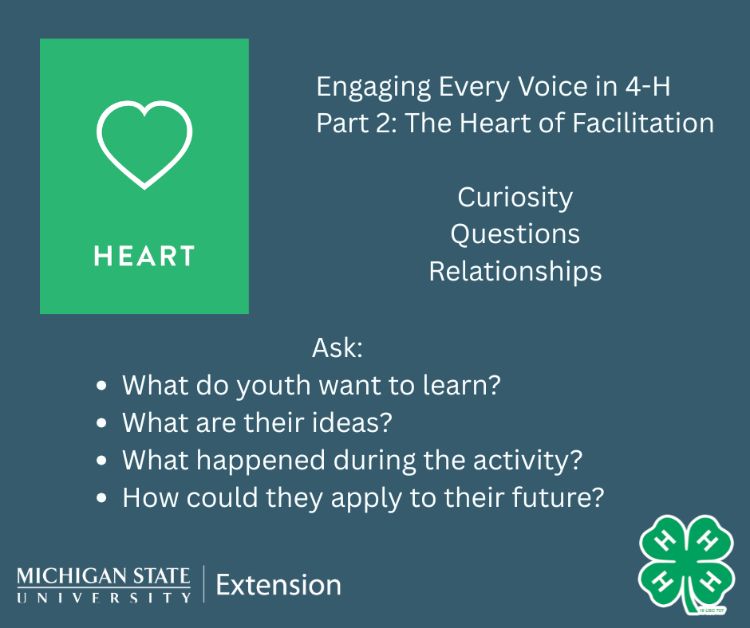Engaging every voice in 4-H: Part 2 – The heart of facilitation
Exploring the second H (heart) of facilitation for 4-H clubs.

In Michigan 4-H, volunteers are creating spaces where all youth feel heard and valued. One key to making this happen is strong facilitation—how we guide meetings, activities and conversations. This four-part series, Engaging every voice in 4-H, takes a closer look at facilitation skills through the lens of the four H’s: head, heart, hands and health.
In this second article in this series, we focus on the heart of facilitation—your approach, mindset and relationships. It’s not just what you do, but how you show up. Michigan State University Extension provides the following tips for heart-centered facilitation.
Curiosity
Heart-centered facilitation is about being flexible and responsive — adapting to youth feedback and group dynamics. It means showing genuine curiosity about what youth are interested in and inviting their input. Ask yourself:
- What do they want to learn or do?
- What are their ideas and perspectives?
- How can they help shape the plan?
Asking these kinds of questions helps create an inclusive culture that honors youth voice and encourages meaningful engagement. This isn’t just a technique — it’s a mindset. It positions youth as capable contributors and co-creators in their 4-H experience.
Questions
The art of asking questions is central to strong facilitation. Questions spark curiosity, support learning and deepen engagement. When youth are encouraged to reflect, share and express themselves, they begin to see their experiences as meaningful and their voices as valuable.
One effective tool to build both curiosity and connection is the Experiential Learning Model. This model guides youth to reflect on their experiences and apply what they’ve learned to new situations. Use questions like:
- What happened during the activity?
- How did it make you feel?
- What did you learn?
- How could you apply this in the future?
Relationships
Above all, strong facilitation is rooted in relationships. Developmental relationships between youth and adults are an important aspect of the 4-H program. Taking time to build trust, show that you care and genuinely connect with youth lays the foundation for positive club environments. When youth feel known and respected, they are more likely to share their thoughts, try new things and fully engage.
Relationship-building doesn't happen by accident — it takes intentional effort. Checking in with youth, celebrating their successes and welcoming their ideas creates a sense of belonging. Belonging is a cornerstone of effective facilitation and thriving youth development.
Facilitation isn’t just about what happens in the moment; it’s also about your approach, mindset and relationships built. These elements—fostering curiosity, showing flexibility and promoting engagement – demonstrate the heart of a strong facilitator. They create the conditions for youth to thrive and ensure that all youth voices are engaged in their 4-H experience.
Explore additional articles in this series: the hands, head and health of facilitation skills.
For additional ideas on how to support youth, consider watching the Michigan 4-H Volunteer Webinar recording, “Engaging Every Voice: Facilitation Skills for Dynamic 4-H Clubs.”



 Print
Print Email
Email




